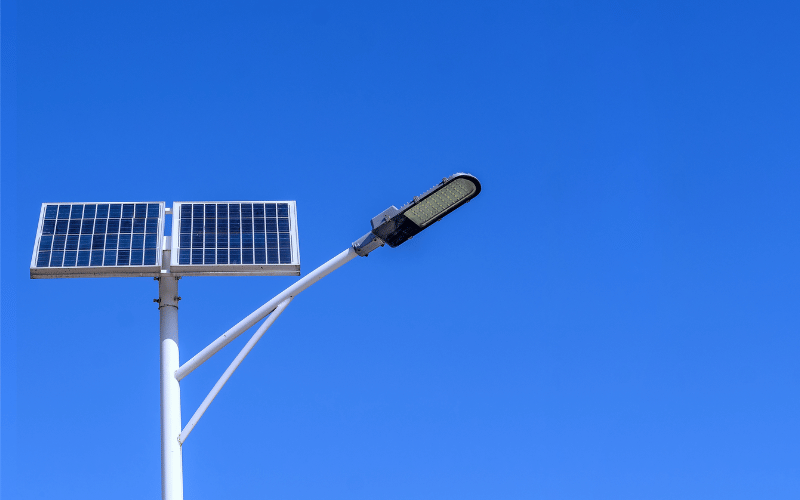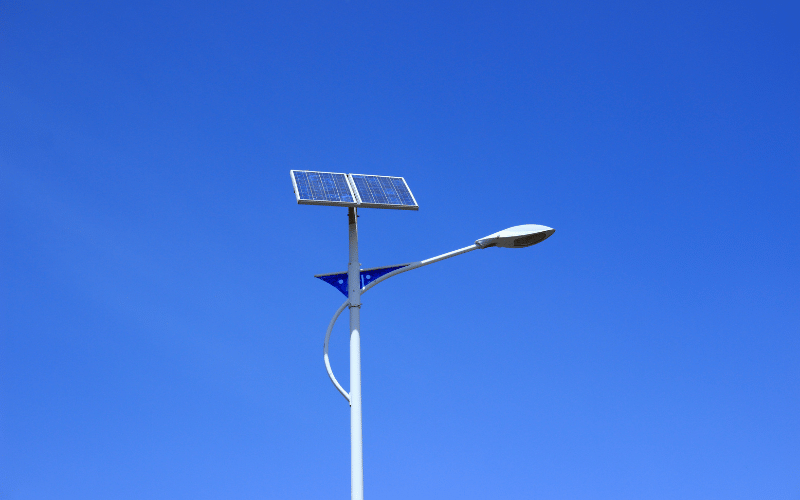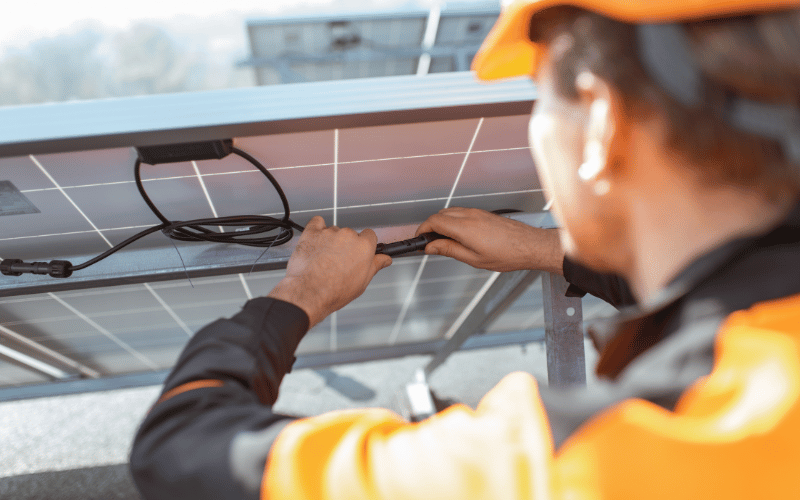Solar street lights harness sunlight to provide efficient, off-grid illumination, offering a sustainable alternative to traditional lighting systems. Their increasing use in urban, suburban, and remote areas underscores their capacity to lower energy costs, mitigate environmental impact, and enhance public safety. Lifespan plays a crucial role in their appeal, as cities, businesses, and homeowners seek long-lasting solutions to maximize cost savings, reduce maintenance, and ensure reliable performance over time.
The lifespan of solar street lights can vary depending on their quality, components, and maintenance. High-quality solar street lights typically last between 10 to 20 years. However, individual components like batteries and LED lights may have shorter lifespans and require replacement. For instance:
- Batteries: Usually last 3 to 5 years, depending on the type and usage.
- LED Lights: Can last 15 to 20 years, as they are highly durable and energy-efficient.
- Solar Panels: Often have a lifespan of 20+ years with proper care.
Regular maintenance, such as cleaning the solar panels and ensuring the batteries are in good condition, can significantly extend the overall lifespan of the system.
Table of Contents
ToggleCore Components and Their Lifespan
Solar street lights rely on several key components that work together to deliver efficient and sustainable lighting. Understanding the role and durability of each part is essential for optimizing performance and planning maintenance.
Overview of Solar Street Light Components
- Solar Panels: These panels, typically made of monocrystalline or polycrystalline photovoltaic cells, capture sunlight and convert it into electricity. Monocrystalline panels are more efficient (up to 22%) and durable, while polycrystalline panels are more cost-effective but slightly less efficient. Environmental factors like dust, shading, and extreme weather can impact their performance and lifespan.
- Batteries: Batteries store the energy collected by the solar panels for nighttime use. Lithium-ion batteries are preferred for their high energy density, long lifespan (5-7 years), and low maintenance, while lead-acid batteries, though cheaper, last only 2-3 years and require more frequent replacements.
- LED Lamps: LEDs are the lighting component of choice due to their energy efficiency and durability. A 30-watt LED can provide the same brightness as a 100-watt traditional bulb while lasting up to 50,000 hours (10-15 years). Their performance remains consistent even in harsh outdoor conditions.
- Controllers and Wiring: Controllers regulate energy flow between the solar panels, batteries, and lamps, ensuring efficient operation and preventing overcharging or discharging. Advanced controllers often include features like remote monitoring and adaptive dimming. Wiring, while durable, can degrade over time due to weather exposure or pest interference, requiring periodic inspections.
Typical Lifespan of Each Component
- Solar Panels: With proper maintenance, high-quality panels can last 20-25 years, even in challenging climates.
- Batteries: Lithium-ion batteries typically last 5-7 years, while lead-acid batteries require replacement every 2-3 years.
- LED Lamps: LEDs offer a lifespan of up to 50,000 hours, translating to 10-15 years of reliable performance.
- Controllers and Electrical Components: Controllers and wiring generally last 5-10 years, depending on quality, usage, and environmental conditions.
This revised section provides more specific details and actionable insights, making it more engaging and informative for readers.
Key Factors Affecting the Lifespan of Solar Street Lights
Understanding the variables that influence the longevity of solar street lights is crucial for making informed decisions about installation and maintenance. Below are the key aspects to consider:
1. Quality of Materials and Manufacturing
The durability and performance of solar street lights are directly tied to the quality of their components and manufacturing standards.
- Impact of Brand and Build Quality
High-quality brands often use advanced materials like monocrystalline solar panels, which are up to 20% more efficient than polycrystalline alternatives. For example, premium models with LiFePO4 (lithium iron phosphate) batteries can last over 2,000 charge cycles—equivalent to 5-7 years—compared to standard lithium-ion batteries, which degrade faster. Investing in corrosion-resistant metals and weatherproof designs also ensures a longer lifespan.
2. Climate and Environmental Conditions
The environment where solar street lights are installed plays a significant role in their longevity.
- Effects of Temperature, Humidity, and Weather
In desert climates, extreme heat can reduce battery efficiency by 10% annually, while sub-zero temperatures in colder regions can lower battery capacity. High humidity accelerates corrosion, potentially shortening the lifespan of components by 15-20%. Choosing lights with a high IP rating (e.g., IP65 or higher) can mitigate these risks. - Urban Versus Rural Installation Considerations
Urban areas often face challenges like pollution and shading from buildings, which reduce solar panel efficiency by up to 15%. In rural areas, dust accumulation on panels can lower energy absorption by 30% if not cleaned regularly.
3. Installation Practices
Proper installation is critical to ensure optimal performance and durability.
- Proper Setup and Positioning
Solar panels should face south and be tilted at a 30-45 degree angle for maximum sunlight exposure. Incorrect alignment can lead to insufficient charging, forcing the battery to discharge deeply and reducing its lifespan. - Protection from Theft or Impact
Installing lights at a height of at least 12 feet and using anti-theft mounting brackets can prevent tampering and accidental damage, saving on replacement costs.
4. Usage and Operation Patterns
How solar street lights are programmed and used directly impacts their lifespan.
- Hours of Illumination Per Night
Operating lights for 12 hours a night can reduce battery life by 25% compared to an 8-hour schedule. Balancing usage with energy storage capacity is essential. - Dimming and Smart Control Features
Advanced features like motion sensors and dimming schedules can optimize energy usage. For instance, a light programmed to run at 30% brightness and increase to 100% only when motion is detected can significantly extend battery life.
Maintenance and Replacement Considerations
Proper maintenance and timely replacements are essential to ensure the long-term performance of solar street lights. Below are detailed recommendations to keep the system in optimal condition:
Routine Inspection and Cleaning Recommendations
Regular inspections are crucial for identifying issues like dirt accumulation, loose connections, or damaged components. For example, in industrial zones with high pollution, cleaning the solar panels every 2-3 months can improve energy absorption by up to 30%. In less polluted areas, a 6-month cleaning schedule may suffice. Additionally, check for corrosion on metal parts and ensure all screws and mounts are secure to prevent structural damage.
Battery Replacement Cycles and Costs
Batteries are one of the most critical components of solar street lights. Lithium-ion batteries typically require replacement every 3-5 years, while LiFePO4 batteries can last up to 7 years. For instance, replacing a 50W solar street light battery with a LiFePO4 model may cost around $200, but the extended lifespan and higher charge cycles make it a cost-effective choice in the long run.
Troubleshooting Common Issues That Reduce Lifespan
Common problems include dim lighting, reduced battery performance, and faulty sensors. For example, if the light dims after only a few hours of operation, it could indicate a battery nearing the end of its lifecycle or insufficient charging due to shading. Sensor malfunctions, which account for 15% of reported issues, are often caused by loose wiring or environmental damage. Inspecting and replacing faulty components promptly can prevent further system failures.
How to Extend the Service Life with Proper Care
To maximize the lifespan of solar street lights, use smart controls like dimming and motion sensors to reduce energy consumption. For instance, programming the light to operate at 30% brightness and increase to 100% only when motion is detected can significantly extend battery life. Additionally, in areas prone to heavy rainfall, installing protective covers for sensors can prevent water damage. Scheduling professional maintenance annually ensures all components, including panels, batteries, and sensors, are functioning efficiently.
Cost Implications: Lifespan and Total Ownership
Evaluating the cost implications of solar street lights requires balancing upfront expenses with long-term savings. By planning for repairs and replacements, municipalities and businesses can maximize financial efficiency while reaping the economic benefits of sustainable lighting solutions.
Comparing Initial Costs vs. Long-Term Savings
Solar street lights typically have higher upfront costs, ranging from $1,500 to $3,000 per unit, compared to traditional lighting. However, they offer significant savings over time. For example, eliminating electricity bills and reducing maintenance can save up to 50% in operational costs over 10 years. A municipality in California, for instance, saved $1.2 million annually after replacing 10,000 traditional streetlights with solar-powered alternatives. High-quality systems with durable components, such as LiFePO4 batteries, further enhance cost efficiency by reducing replacement frequency.
Budgeting for Repairs and Replacements
Allocating funds for periodic repairs and replacements is crucial to maintaining optimal performance. For example, replacing a battery every 5-7 years or repairing damaged sensors can cost between $100 and $300 per unit. To avoid unexpected financial strain, it’s recommended to set aside 10-15% of the initial installation cost annually for maintenance. This proactive approach ensures uninterrupted operation and extends the system’s lifespan.
Economic Advantages for Municipalities and Businesses
Solar street lights provide substantial economic benefits, particularly for large-scale installations. Municipalities can reduce energy consumption by up to 70%, saving millions in energy costs annually. In rural areas without grid access, solar lighting eliminates the need for expensive infrastructure, saving up to $10,000 per mile of road. Businesses also benefit from reduced operational expenses and potential tax incentives for adopting sustainable energy solutions. For example, a logistics company reduced its outdoor lighting costs by 40% within three years of switching to solar street lights, demonstrating the long-term value of this investment.
Signs a Solar Street Light Needs Replacement
Timely identification of wear and tear in solar street lights can prevent costly failures and ensure uninterrupted performance. Below are the key indicators that suggest components may need repair or replacement, along with practical advice on when a full replacement is the better option.
Key Indicators for Each Component Reaching End-of-Life
Each component in a solar street light has a defined lifespan. For instance, batteries typically last 3-7 years, while LED lights can operate for over 50,000 hours. If you notice reduced brightness, shorter operating hours, or physical damage to components like the solar panel, it’s a clear sign they may be nearing the end of their lifecycle. For example, a battery that no longer holds a charge after 4 years may need replacement.
Dimming or Flickering Lights
Dimming or flickering lights are common signs of component failure. If the light dims after only a few hours of operation, the battery may be depleted or unable to hold a full charge. Flickering could indicate loose wiring, a failing LED driver, or even moisture intrusion. For instance, in coastal areas, corrosion from salt air can cause wiring issues, leading to flickering.
Reduced Charging Efficiency
When a solar panel takes longer to charge the battery or fails to reach full capacity, it may be due to dirt buildup, shading, or panel degradation. Cleaning the panel or repositioning it can often resolve the issue. However, if the problem persists, it may indicate that the panel’s efficiency has dropped below 80%, a common threshold for replacement.
Faulty Controllers or Wiring Problems
Controllers and wiring are critical for the proper functioning of solar street lights. If the light doesn’t turn on or off at the scheduled time, the controller may need reprogramming or replacement. Damaged or corroded wires can also cause intermittent performance. For example, exposed wiring in high-humidity areas can lead to short circuits, requiring immediate attention.
When Repair Is Practical and When Full Replacement Is Better
Minor issues, such as loose connections or a depleted battery, can often be resolved with repairs. For example, replacing a battery typically costs $100-$300, depending on the type and capacity. However, if multiple components fail simultaneously or the system is over 10 years old, a full replacement may be more cost-effective. Upgrading to a modern, energy-efficient model can reduce maintenance costs by up to 30% and improve overall performance.
Frequently Asked Questions About Solar Street Light Lifespan
Q: What is the average lifespan of a solar street light?
A: The average lifespan of a solar street light is around 10-15 years, depending on the quality of its components. LED lights can last over 50,000 hours, while batteries typically need replacement every 3-7 years. High-quality systems with durable materials tend to last longer.
Q: How often do batteries in solar street lights need to be replaced?
A: Batteries in solar street lights usually need replacement every 3-7 years. Lithium-ion batteries last around 3-5 years, while LiFePO4 (lithium iron phosphate) batteries can last up to 7 years. Regular maintenance and proper charging cycles can extend battery life.
Q: Do solar street lights last longer than traditional street lights?
A: Yes, solar street lights generally last longer than traditional street lights. While traditional lights rely on grid power and often require frequent bulb replacements, solar street lights use long-lasting LEDs and renewable energy, reducing maintenance and operational costs.
Q: Can weather affect how long a solar street light works?
A: Yes, weather can significantly impact the lifespan of a solar street light. Extreme temperatures can degrade batteries, while high humidity may cause corrosion. Dust, snow, and shading can reduce solar panel efficiency, so regular cleaning and maintenance are essential.
Q: Is it easy to replace parts like batteries or LEDs?
A: Yes, replacing parts like batteries or LEDs is relatively easy. Most solar street lights are designed with modular components, allowing for quick and straightforward replacements. Always follow the manufacturer’s guidelines to ensure proper installation.
Q: How can you make a solar street light last longer?
A: To extend the lifespan of a solar street light, clean the solar panels regularly, inspect components for damage, and use smart controls like dimming or motion sensors to optimize energy usage. Protecting the system from extreme weather and scheduling annual maintenance also helps.
Q: What are the main reasons for early failure?
A: Early failure in solar street lights often occurs due to poor-quality components, improper installation, or lack of maintenance. Common issues include battery degradation, faulty wiring, and reduced solar panel efficiency caused by dirt or shading. Investing in high-quality systems and regular upkeep can prevent these problems.
Conclusion
Several factors influence the durability of solar street lights, including the quality of materials, environmental conditions, proper installation, and regular maintenance. To get the best value from your investment, choose high-quality systems, schedule routine inspections, and use smart features like dimming and motion sensors to optimize performance and extend lifespan.




